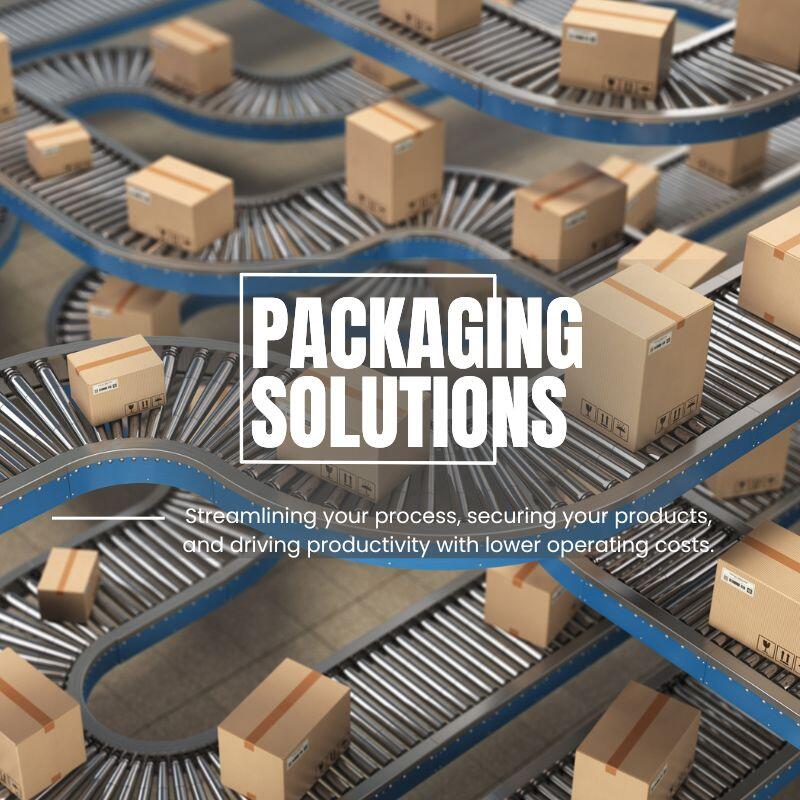Packaging Machine Care and Maintenance Tips
- Home
- Solutions
- By Application
- Packaging Machine Care and Maintenance Tips
Packaging Machine Care and Maintenance Tips
Packaging machines are a significant investment, so naturally, you want them to perform at their peak for as long as possible.
How well they perform directly affects your production output, product quality, and profitability. But like any other machine, they need regular, consistent attention to stay in top working condition.
Preventative maintenance is the answer to long-lasting, reliable production. Why? Let’s find out.
Why Regular Packing Machine Maintenance is Necessary
Regular and consistent machine maintenance keeps your packaging lines running smoothly. Without it, you risk machine breakdowns, reduced efficiency, and sudden downtimes — it's disruptive and costly.
Being proactive with machine maintenance and upkeep helps you:
1. Extend Machine Lifespan
Packaging machines are a big investment, and maximizing that investment means ensuring they last as long as possible.
Without proper care, factors like friction, vibration, and material buildup can damage parts faster than expected. Regularly addressing machine wear and tear prevents minor issues from snowballing into major repairs.
2. Improve Operational Efficiency
A well-maintained machine is less likely to cause production delays, product damage, and rework. Inconsistent upkeep can lead to machine glitches or slow-downs that affect your overall production flow.
That’s why proactive maintenance ensures higher output and a more predictable operation, maximizing uptime and throughput.
3. Enhance Product Quality
Product quality extends to the packaging itself, so product integrity and presentation are crucial.
Proper machine maintenance ensures that each product is precisely filled, sealed, and labeled. So, your business benefits from a consistently high-quality final product and fewer rejects.
4. Reduce Operational Costs
Preventing breakdowns through regular maintenance is far more cost-effective than emergency repairs. Besides the premium charges for parts and labor costs, you also lose production time.
Scheduled maintenance allows you to manage your budget effectively and avoid hefty financial hits.
5. Ensure Operator Safety
Regular inspections and upkeep protect your operators from dangerous malfunctions. Consistent maintenance ensures critical safety features, such as emergency stops and protective guarding, are always fully functional.
Proactive machine maintenance minimizes work injuries and ensures compliance with workplace safety regulations.
5 Tips for Effective Packaging Machine Maintenance
Use these 5 expert tips to help you maximize the performance and lifespan of your packaging machinery:
1. Implement a Preventive Maintenance Plan
Having a preventative maintenance plan is the first step to long-lasting packaging machines. Start by creating a detailed schedule for weekly, monthly, and quarterly maintenance tasks. This blueprint should be based on your equipment manufacturer's recommendations.
Then, as you follow this plan, keep records of the date, performed tasks, maintenance personnel, and the machine's operational status. These records will provide data for performance analysis and accurate future budgeting.
2. Clean and Inspect Equipment Regularly
Beyond scheduled maintenance, daily cleaning and inspection are vital for operational health. After each production shift, clean the interior and exterior of your equipment. This prevents dust and debris accumulation — a common culprit of premature wear and malfunctions.
While cleaning, inspect mechanical components for any signs of wear or unusual noises. Moreover, lubricate moving parts, such as bearings, guide rails, and chains, to prevent friction and overheating, and replace consumables like belts, rollers, and seals before they fail.
3. Create an Emergency Response System
Even with robust preventive maintenance, machine breakdowns can still happen. So, it’s important to have an emergency response system in place as your safety net.
This system relies on 3 key components:
- Establishing an emergency contact network: This will allow your team to quickly reach relevant personnel and coordinate technical support.
- Spare parts inventory management: Maintain a stock of critical components and spare parts to minimize downtime when equipment issues arise.
- Professional training for maintenance personnel: Train maintenance staff to improve their troubleshooting, repair capabilities, and safety awareness.
4. Ensure Correct Equipment Operation
Train your operators to maintain correct operating procedures at all times. This means making sure they understand proper startup, shutdown, and routine adjustments and avoiding overloading that may damage machines.
The best way to standardize operations is to establish and enforce standard operating procedures (SOPs). These guidelines ensure every operator follows the same steps, boosting efficiency and minimizing human error.
Regular refreshers and ongoing training will also help your team be on the same page about best practices and machine safety.
5. Utilize Technical Support and Supplier Relations
Not all equipment issues can be resolved in-house, especially complex malfunctions. In these cases, seeking professional technical support can help avoid prolonged and costly downtime.
Reputable packaging machinery manufacturers or specialized repair services offer extensive experience and technical expertise to diagnose and fix challenging issues quickly.
Building strong, reliable supplier relations can also bring substantial benefits like faster response times, priority for parts, or even remote support.
FAQs
Q1: What are common packaging machine malfunctions, and how can they be prevented?
Answer: Common malfunctions with packaging machinery often include wear of mechanical components, electrical system failures, transmission system issues, and sensor malfunctions.
The good news is having a preventive maintenance program with maintenance schedules and daily inspections and cleaning can help prevent these issues. Replacing worn parts promptly and lubricating critical parts also keep machines running smoothly.
Moreover, maintaining an optimal operating environment, such as controlling temperature and humidity, avoiding overload, and ensuring stable power supply, plays a key role in machine stability and reliability.
Q2: Which parts of end-of-line packaging machines require regular replacement?
Answer: Consumables and wear parts, including conveyor belts, suction cups, case sealing blades, pneumatic seals, chains, bearings, and lubricants, should have fixed replacement cycles.
While replacement frequency depends on usage, replacing them every six months to a year is generally recommended.
Q3: What maintenance tasks should be handled by OEM technical personnel?
Answer: For maintenance tasks involving core equipment components, such as servo motors, control software updates, and PLC system maintenance, it’s best to rely on your OEM.
Other tasks requiring precision calibration and component upgrades are best handled by OEM engineers, too, as they have proprietary knowledge and specialized tools designed for their equipment.
CHUEN AN PACK: Expert Support for Your Packaging Machines
Proactive packaging machine maintenance gives you a competitive edge — it guarantees consistent production, operational efficiency, and an extended machine lifespan.
By implementing robust preventive measures, training your team, and knowing when to seek professional help, you can get the most from your packaging machinery.
Need a reliable packaging maintenance expert? CHUEN AN PACK offers specialized insights and expert assistance. Reach out today with any questions and see how we can help.


